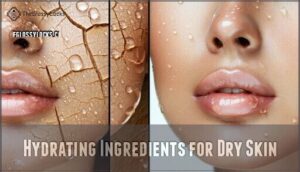This site is supported by our readers. We may earn a commission, at no cost to you, if you purchase through links.

Look for ingredients like ceramides, hyaluronic acid, and glycerin that actually lock in moisture rather than just sitting on surface. Gentle, fragrance-free products work best since irritated skin doesn’t need extra drama.
Sometimes dry patches signal deeper issues like eczema or nutritional gaps that need attention. The key isn’t just slapping on any moisturizer – it’s understanding why your skin’s crying for help and responding with the right combination of products and habits.
Table Of Contents
- Key Takeaways
- Causes of Dry Patches
- Dealing With Dry Patches
- Choosing Moisturizers
- Adjusting Skincare Routine
- Lifestyle Changes for Healthy Skin
- Frequently Asked Questions (FAQs)
- How do you fix dry patches on your skin?
- Should I moisturize a rash or let it dry out?
- Will dry patches go away?
- Can dry patches indicate a serious health issue?
- Is it common for dry patches to itch?
- How do different seasons affect skin dryness?
- Are there specific fabrics that worsen dry patches?
- What role do allergies play in skin dryness?
- When should dry patches be checked professionally?
- Can dry patches spread to other areas?
- Conclusion
Key Takeaways
- Moisturize damp skin twice daily – Apply fragrance-free moisturizers with ceramides, hyaluronic acid, or glycerin while your skin is still wet to lock in maximum hydration.
- Switch to gentle, lukewarm cleansing – Replace harsh soaps with mild, pH-neutral cleansers and use lukewarm water instead of hot to prevent stripping your skin’s natural oils.
- Address environmental triggers – Add a humidifier to dry indoor spaces, wear soft cotton fabrics, and protect your skin from cold weather and air conditioning.
- See a dermatologist for persistent patches – If dry areas do not improve after two weeks of consistent care, or if they crack, bleed, or spread, you will need professional evaluation to rule out underlying conditions like eczema or psoriasis.
Causes of Dry Patches
Your skin can develop dry patches when environmental factors strip away natural moisture.
Understanding these root causes helps you choose the right treatment approach to restore healthy, hydrated skin.
Environmental Factors and Dry Skin
Environmental factors act like invisible enemies attacking your skin’s natural defenses daily.
Environmental threats silently steal your skin’s moisture barrier every single day.
Cold weather and low humidity strip moisture from your skin, while air conditioning creates desert-like conditions indoors.
Winter amplifies these effects, causing skin dryness through wind burn and sun exposure reflecting off snow.
Understanding these environmental triggers helps you protect against dry skin patches year-round.
Additionally, harsh soaps and cleansers can also compromise the skin’s natural defenses.
Underlying Medical Conditions and Dry Patches
Several medical conditions can turn your skin into a battlefield, creating persistent dry patches that resist typical moisturizing efforts.
These underlying health issues disrupt your skin’s natural barrier function and moisture retention.
Here are four major medical culprits behind stubborn dry patches:
- Eczema specifics – Atopic dermatitis weakens skin barriers, causing chronic inflammation and recurring dry, itchy patches
- Psoriasis causes – Autoimmune dysfunction triggers thick, scaly patches with silvery scales on elbows, knees, and scalp
- Dermatitis types – Contact and seborrheic varieties create localized dryness from allergens or overactive oil glands
- Ichthyosis vulgaris – This genetic condition produces fish-scale-like dryness, primarily affecting legs and arms
Rosacea triggers also contribute to facial dryness and sensitivity in millions of Americans. Kidney and thyroid problems can also contribute to skin issues, so rule out diseases for persistent dryness.
Nutritional Deficiencies and Skin Health
Your body needs specific nutrients to maintain healthy skin, and deficiencies can trigger dry skin patches.
Feed your skin from within – deficiencies show up as dry, flaky patches on the surface.
Vitamin D, zinc deficiency, and iron shortages directly impact your skin’s ability to retain moisture.
Omega-3s and antioxidants help repair your skin barrier, while nutritional deficiencies from poor dietary choices leave your skin vulnerable to dryness and irritation, highlighting the importance of healthy skin.
Dealing With Dry Patches
When dry skin patches appear, swift action prevents them from worsening into painful, cracked areas. Patch identification helps determine whether you’re dealing with temporary dryness or symptoms requiring specialist options.
Here’s your action plan:
- Assess severity – Note if patches are simply flaky or showing severe symptoms like bleeding, deep cracks, or intense itchy dry skin.
- Start gentle treatment – Apply fragrance-free moisturizer twice daily while skin’s still damp.
- Try home exfoliation** – Use a soft washcloth or gentle scrub once weekly to remove dead skin.
- Monitor progress – If dry skin patches persist after two weeks of consistent skin dryness treatment, consider prescription creams.
Don’t ignore stubborn patches that resist basic care. Sometimes what looks like simple flaky skin causes actually signals underlying conditions requiring professional evaluation for effective dry skin relief.
Choosing Moisturizers
You’ll find the right moisturizer by focusing on ingredients that lock in moisture and repair your skin’s protective barrier.
Look for products containing hyaluronic acid, ceramides, or glycerin, which draw water to your skin and keep it there longer.
Hydrating Ingredients for Dry Skin
Looking beyond basic moisturizing, specific hydrating ingredients can transform your dry skin patches into healthy, supple skin.
Humectant benefits include drawing moisture from the air, while emollient properties smooth rough textures.
Occlusive agents lock in hydration by forming protective barriers.
Ceramides explained simply: they’re natural lipids that repair your skin barrier. You can find products for ceramide skin repair to help restore the skin’s natural barrier.
Natural oils provide deep nourishment for lasting moisturizing dry skin results, which is essential for achieving healthy skin and maintaining natural barrier function with the help of ceramide skin repair.
Natural Moisturizers for Sensitive Skin
Natural moisturizers work wonders for sensitive skin without harsh chemicals.
Aloe Vera penetrates quickly, delivering 99% water content that soothes irritated dry skin patches while forming protective barriers. Coconut oil provides clinical-grade hydration with antimicrobial benefits, reducing eczema severity up to 68%.
Shea butter locks moisture deep within skin layers, perfect for spot-treating stubborn patches. DIY Recipes combining these Plant Extracts create powerful moisturizing blends.
Honey Masks offer additional healing properties for sensitive skin care routines. These oils also offer skin barrier repair with natural moisturizers, Aloe Vera, Coconut oil, Shea butter, and Honey Masks.
Fragrance-Free Moisturizers for Irritated Skin
Fragrances can turn your skincare routine into a nightmare when you’re dealing with irritated skin.
Choose fragrance-free moisturizers specifically formulated for sensitive skin care to avoid triggering reactions. These hypoallergenic options provide gentle skin barrier repair without the risk of contact dermatitis or worsening dry skin patches.
- Peace of mind knowing you won’t accidentally inflame your already angry skin
- Relief from the constant worry about hidden irritants in your skincare products
- Confidence that your eczema relief routine won’t backfire with unexpected flare-ups
Moisturizer Application Techniques for Dry Patches
Proper application frequency matters more than you might think.
Apply moisturizer to damp skin using gentle patting motions, then layer products from thinnest to thickest consistency.
This layering technique creates an effective occlusive barrier that locks in moisture.
Consider using products with ceramides for repair to improve your skin barrier.
Focus extra attention on dry skin patches during your nighttime hydration routine for best results.
Adjusting Skincare Routine
Your current skincare routine might need a complete overhaul if dry patches keep appearing despite your best efforts.
The right combination of gentle cleansing, strategic exfoliation, and moisture-locking products can transform stubborn dry areas into smooth, healthy skin, which is the ultimate goal of a complete skincare routine.
Gentle Cleansing for Dry Skin
Switch out harsh cleansers for mild alternatives like syndet cleansers that won’t strip your skin’s natural oils.
Use lukewarm water instead of hot—scalding temperatures can worsen dry skin patches.
Limit cleansing frequency to once daily, focusing on gentle products with minimal cleanser ingredients.
After washing, pat dry with a soft towel rather than rubbing, which protects your delicate skincare barrier.
Consider using a cleanser with hyaluronic acid and ceramides for added hydration and to help with dry skin.
Exfoliating Techniques for Dry Patches
After gentle cleansing, proper exfoliation helps remove flaky skin and improve texture. Chemical peels with AHAs work better than physical scrubs for dry patches, reducing irritation while encouraging healthy skin turnover.
For effective skin renewal, consider using AHA based peels. Always follow with moisturizer and SPF for ideal post-exfoliation care.
- Gentle exfoliation: Use chemical peels 1-2 times weekly instead of harsh physical scrubs
- Enzyme exfoliation: Try enzyme-based products for sensitive areas prone to scaling skin
- Avoid over-exfoliating: Skip daily exfoliation to prevent increased dryness and irritation
- Post-exfoliation care: Apply hydrating moisturizer immediately after to restore skin barrier
Toner and Essence for Hydrating Dry Skin
Why settle for basic hydration when toner benefits include deeper moisture penetration?
Hydrating toners with hyaluronic acid or glycerin prep your skin for better product absorption. Essence ingredients like ceramides and peptides provide additional hydration layers.
Apply using gentle patting motions, allowing each layer to absorb before adding moisturizers. These layering techniques maximize your skin care routine‘s effectiveness.
Serum and Face Mask for Locking in Moisture
Beyond basic moisturizing, serums and face masks deliver concentrated hydration deep into dry patches.
Layer hydrating serums under moisturizer for ingredient synergy that locks moisture effectively.
- Serum Benefits: Apply hyaluronic acid serums twice daily for intense hydration
- Mask Hydration: Use overnight masks weekly for deep moisture repair
- Application Frequency: Layer serums before moisturizer for maximum absorption
- Ingredient Synergy: Combine ceramides with niacinamide for barrier protection
For ideal results, consider using hydrating facial products.
Lifestyle Changes for Healthy Skin
Your skincare routine isn’t the only factor affecting those stubborn dry patches—your daily habits play a vital role too.
Simple lifestyle adjustments can dramatically improve your skin’s moisture levels and prevent future dryness from developing, which makes simple adjustments and daily habits crucial for skincare.
Staying Hydrated From The Inside Out
Your skin needs water from the inside to stay healthy.
Drinking enough water maintains skin hydration and prevents dehydration that leads to dry patches. Aim for eight glasses daily, but your water intake needs may vary.
Include hydrating foods like watermelon and cucumbers. Choose beverages wisely—limit caffeine and alcohol, which can disrupt electrolyte balance and reduce skin moisture.
A consistent skincare routine, guided by expert dermatologist advice, is also essential for superior skin health and maintaining healthy skin habits.
Humidifying Your Environment for Dry Skin
While staying hydrated helps from within, your environment’s air moisture plays a huge role in preventing dry patches.
Low humidity pulls moisture from your skin, making dryness worse. A humidifier adds needed moisture back into the air.
Choose cool-mist models for year-round use, and aim for 30-50% humidity levels.
Place your humidifier near where you spend the most time, but keep it away from walls to prevent mold. Regular cleaning prevents bacteria buildup and keeps your skin care routine working effectively.
Avoiding Harsh Soaps and Cleansers
Commercial soaps contain harsh alkaline ingredients that strip your skin’s natural oils and disrupt pH balance.
Switch to mild cleansers or syndet cleansers with neutral pH levels for effective patch prevention.
Look for soap ingredients like glycerin and ceramides in gentle products. These cleanser alternatives maintain your skin’s protective barrier while providing gentle exfoliation without irritation.
Wearing Gentle Fabrics for Sensitive Skin
Your clothing choices can make or break your skin’s comfort.
Natural fibers like cotton, bamboo, and silk breathe better than synthetic materials, reducing fabric irritation. Weave matters too—looser weaves allow airflow while tight weaves trap moisture.
Check for dye sensitivity by choosing undyed or naturally-dyed garments. Proper clothing fit prevents chafing that worsens skin patches and irritation, which is crucial for overall skin comfort.
Managing Stress for Skin Health
Your body’s stress response can wreak havoc on your skin.
When you’re stressed, cortisol levels spike, breaking down your skin’s protective barrier and triggering inflammation.
This creates a vicious cycle – dry skin patches cause more stress, which worsens dryness.
Combat this mind-body connection through relaxation techniques like meditation and deep breathing.
Prioritize sleep quality to support skin repair and reduce stress hormones naturally.
Frequently Asked Questions (FAQs)
How do you fix dry patches on your skin?
Apply gentle moisturizers with humectants like hyaluronic acid twice daily. Use lukewarm water when bathing, add a humidifier to dry environments, and avoid harsh soaps that strip natural oils.
Should I moisturize a rash or let it dry out?
Absolutely moisturize that rash!
Dry skin screams for hydration, not punishment.
Use gentle, fragrance-free moisturizer to soothe irritation and support healing.
Letting rashes dry out typically worsens inflammation and delays recovery, so it is crucial to keep the area hydrated.
Will dry patches go away?
Most dry patches will improve with proper care, but timeline depends on the cause.
Temporary dryness from weather or products usually resolves in days to weeks with moisturizing and gentle care.
Can dry patches indicate a serious health issue?
While most dry patches aren’t serious, they can sometimes signal underlying conditions like eczema, psoriasis, or allergies. If patches persist, crack, bleed, or worsen despite care, you’ll want dermatologist evaluation.
Is it common for dry patches to itch?
Yes, it’s very common for dry patches to itch.
The lack of moisture irritates nerve endings under your skin, triggering that familiar scratchy sensation that makes you want to scratch constantly.
How do different seasons affect skin dryness?
Winter’s cold air and low humidity strip your skin’s natural moisture, while summer’s sun and air conditioning can also cause dryness.
You’ll notice more patches during seasonal shifts when your skin adjusts to changing conditions, which can be particularly problematic due to the dryness.
Are there specific fabrics that worsen dry patches?
Ever wondered why your clothes feel like sandpaper against irritated skin?
Wool, synthetic fabrics, and rough textures can trap heat and friction, worsening dry patches—choose soft cotton or bamboo instead.
What role do allergies play in skin dryness?
Allergies trigger your immune system, causing inflammation that disrupts your skin’s protective barrier.
This leads to increased water loss, irritation, and persistent dryness, especially with allergens like pollen, pet dander, or harsh chemicals, which can be considered a disrupts factor.
When should dry patches be checked professionally?
You should see a professional if dry patches persist despite moisturizing, crack or bleed, spread rapidly, show signs of infection, or accompany other concerning symptoms like fever or severe itching.
Can dry patches spread to other areas?
Though many assume dry patches stay put, they can indeed spread under certain conditions.
Scratching damaged skin creates openings for bacteria or fungi to spread.
Contact dermatitis and eczema often expand to nearby areas through continued irritant exposure or scratching behaviors.
Conclusion
Transforming battle-scarred skin into silky perfection doesn’t happen overnight, but consistency pays off.
Learning how to deal with dry patches on skin requires patience and the right approach.
You’ve got the knowledge now—gentle cleansing, quality moisturizers with ceramides and hyaluronic acid, lifestyle tweaks, and knowing when to see a dermatologist.
Your skin’s begging for relief, so start with one change today and build from there, remembering that gentle cleansing is a crucial step.
- https://www.mayoclinic.org/diseases-conditions/dry-skin/symptoms-causes/syc-20353885
- https://www.clarinsusa.com/en/beauty-faq/face/dry-skin-patches-causes-treatment/
- https://www.scripps.org/news_items/4568-what-causes-dry-white-patches-on-skin
- https://www.eucerinus.com/skin-care-101/dry-skin/why-is-my-skin-so-dry
- https://www.cerave.com/skin-smarts/skincare-tips-advice/dry-skin-remedies













